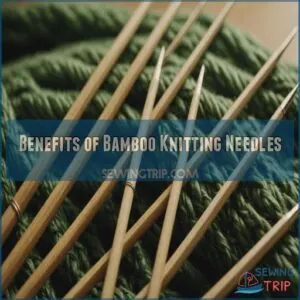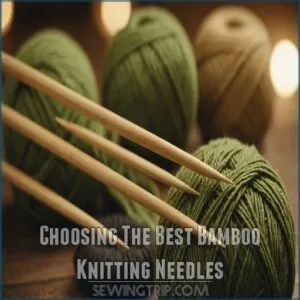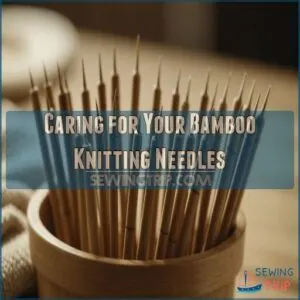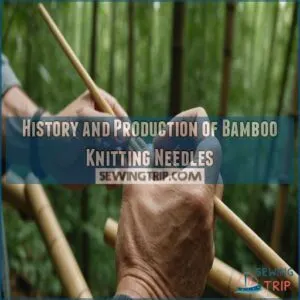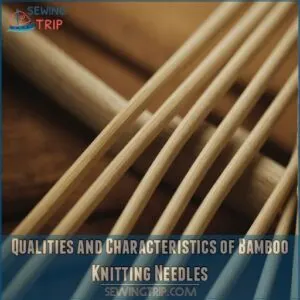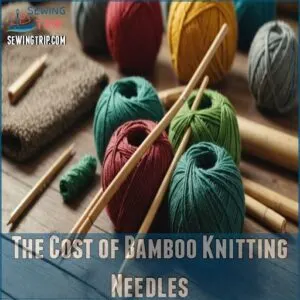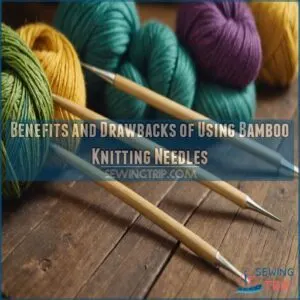This site is supported by our readers. We may earn a commission, at no cost to you, if you purchase through links.
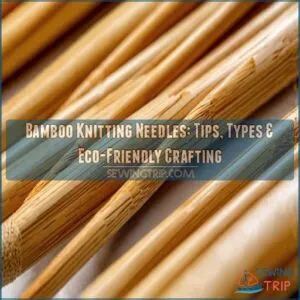 You’ll love bamboo knitting needles! They’re lightweight and warm, a cozy contrast to cold metal.
You’ll love bamboo knitting needles! They’re lightweight and warm, a cozy contrast to cold metal.
Plus, they’re eco-friendly – a win for your hands and the planet. Their quiet clicking makes for peaceful knitting sessions, anywhere.
Choosing the right bamboo knitting needles depends on your project and preference; consider needle size and length.
You’ll find that the smooth glide of yarn makes for a more enjoyable experience.
Want to master your next project? We’ll share some expert tips on selecting the perfect pair…
Table Of Contents
- Key Takeaways
- Benefits of Bamboo Knitting Needles
- Choosing The Best Bamboo Knitting Needles
- Caring for Your Bamboo Knitting Needles
- History and Production of Bamboo Knitting Needles
- Qualities and Characteristics of Bamboo Knitting Needles
- The Cost of Bamboo Knitting Needles
- Benefits and Drawbacks of Using Bamboo Knitting Needles
- Frequently Asked Questions (FAQs)
- Conclusion
Key Takeaways
- You’ll appreciate bamboo knitting needles for their lightweight, warm texture, making them ideal for comfortable, quiet crafting sessions anywhere.
- They offer an eco-friendly option due to their sustainable bamboo sourcing, which supports environmentally conscious knitting practices.
- Proper care, including gentle cleaning and safe storage, ensures these needles remain smooth and last for years, enhancing your knitting experience.
- Bamboo needles are versatile for various projects, from cozy sweaters to delicate lacework, providing a gentle, controlled feel that’s perfect for beginners and experienced knitters alike.
Benefits of Bamboo Knitting Needles
You’ll appreciate bamboo knitting needles for their warm, comfortable feel and eco-friendly nature.
They’re lightweight, making them easy to carry around.
You’ll enjoy quieter crafting sessions compared to using metal needles.
Warm and Comfortable to Use
When you knit with bamboo knitting needles, you’ll notice the warm, comfortable texture—a world apart from the cold metal needle feel.
It feels like a cozy embrace for your hands, offering a more enjoyable knitting experience.
Bamboo’s natural warmth and eco-friendly nature make it a top choice over metal needles, ensuring you knit comfortably and sustainably.
Lightweight and Portable
Imagine yourself, needles in hand, ready for travel knitting!
Bamboo needles, being lightweight, are perfect for on-the-go projects.
Their compact storage makes them ideal for slipping into a portable case.
Lightweight sets, like interchangeable knitting needles or double pointed needles from various knitting needle brands, are easily packed.
You’ll master your next project with ease!
Eco-Friendly and Sustainable
You’ve got your bamboo knitting needles, lightweight and perfect for on-the-go crafting.
Now, let’s chat about their eco-friendly nature.
Bamboo is a sustainable choice, sourced through eco-conscious forestry practices, but it’s important to be aware that the process of turning bamboo into fabric or other products can involve harsh chemicals if not done responsibly, as seen in some eco friendly fabric alternatives.
You can even find options made from recycled bamboo.
These knitting accessories are a prime example of eco-friendly alternatives in knitting supplies, blending practicality with sustainability.
Quieter Than Metal Needles
Bamboo knitting needles don’t just care for the planet, they also pamper your ears.
You’ll appreciate the noise-reduction when switching from clattering metal needles.
This quiet knitting lets you knit peacefully anywhere, without metal needle sound interruptions.
With bamboo, the yarn glides smoothly, making crafting a serene experience.
It’s a game-changer for circular knitting needles and knitting needle reviews alike.
Choosing The Best Bamboo Knitting Needles
When choosing the best bamboo knitting needles, consider factors like size, comfort, and versatility to match your knitting projects.
Checking reviews and ratings can guide you in selecting the most reliable and user-friendly options available.
Factors to Consider in Selection
Choosing the best bamboo knitting needles involves several factors.
Consider needle size by selecting the right large needle sizes for your thicker yarns and heavier fabrics, and project type—small sizes for socks or large ones for sweaters.
Think about needle length for comfort, and check the yarn label recommendations to make sure the right needle size and gauge.
Match your budget with brand reputation; quality varies.
Don’t forget eco-friendly knitting practices; bamboo shines here.
Sustainable knitting means supporting Earth’s wellbeing while crafting joyfully.
Reviews and Ratings of Popular Options
Searching for the best bamboo knitting needles can be a journey.
You can shop online for a wide variety of options at Bamboo Knitting Needles Online.
Look at popular brands through knitting needle reviews to spot standout options.
Customers rave about seamless finishes, while some highlight unique needle size recommendations.
Check knitting needle ratings for honest insights from the knitting needle community.
Their feedback becomes invaluable, a treasure map guiding you to the finest tools!
Caring for Your Bamboo Knitting Needles
To keep your bamboo knitting needles in great shape, it’s important to follow some simple care tips.
Proper cleaning and storage will help your needles remain smooth and ready for your next project.
Cleaning and Maintenance Tips
Now that you’ve chosen your perfect bamboo needles, let’s talk care!
Gentle soap and water work wonders for cleaning; avoid harsh chemicals.
Dry them thoroughly with a soft cloth to prevent warping or damage.
For stubborn stains, try a mild abrasive cleaner.
Proper bamboo needle care involves understanding the differences between knitting and sewing basics differences in knitting, as this knowledge can impact how you handle and store your needles, and keeps your knitting needle craft thriving!
Following these simple steps guarantees years of happy knitting.
Storage and Organization Ideas
Imagine this: you’re rummaging for bamboo needles, and they’re a tangled mess.
Avoid this knitting nightmare with smart storage like needle rolls or project bags.
You can even find a great bamboo knitting needle set to help you organize your needles.
Drawer organizers keep your needle obsession under control, and DIY solutions or travel cases offer perfect portability.
Streamline your stash with effective knitting needle organization, ensuring every project is a breeze to start.
Handling and Repairing Damaged Needles
Got a damaged needle? You’re not alone. Many knitters face this, but you can handle it with ease.
- For broken tips, sand the edges smoothly and apply a bit of wood glue.
- Loose joints? Tighten with a small dab of glue.
- Embrace your needle repair skills and show off your handmade needles with pride.
Extending The Life of Your Needles
After fixing those pesky breaks, cherish your knitting needle talent by extending your needles’ life.
Remember, proper cleaning avoids harsh chemicals.
Needle storage is essential—store them flat to prevent warping.
Occasionally, use oiling tips to maintain their smoothness.
Handle carefully; they deserve love as your knitting needle passion grows.
| Tip | Reason | Frequency |
|---|---|---|
| Clean gently | Prevents damage | Monthly |
| Store flat | Avoids warping | Always |
| Oil lightly | Keeps smooth | Yearly |
History and Production of Bamboo Knitting Needles
When you explore the history of bamboo knitting needles, you’ll find they evolved from simple tools into cherished crafting essentials.
The production process utilizes a renewable resource and also supports communities involved in sustainable bamboo harvesting.
Origins and Evolution of Bamboo Needles
Bamboo needles have a rich history woven into traditional crafting techniques.
Initially simple tools, they’ve evolved alongside modern manufacturing, echoing sustainability’s rise.
As bamboo entered the knitting needle market, manufacturers focused on eco-friendly material sourcing, a trend that aligns with the growing interest in breathable natural alternatives.
Today, they’re important due to their comfort and environmental impact.
- Eco-friendliness
- Material versatility
- Knitting needle trends
- History and innovation
- Market growth
The Manufacturing Process
From bamboo harvesting to crafting exquisite double-pointed and straight needles, the production blends tradition with innovation.
Quality control guarantees each needle is shaped to perfection, ready for your creative ventures.
Clever finishing techniques give them a smooth touch, making knitting a delight.
Excellent knitting needle suppliers and retailers guarantee you’re crafting with the best tools in the market.
Impact on The Environment and Communities
Since bamboo is a renewable resource, choosing these needles reduces your carbon footprint.
You’re supporting sustainable practices!
Consider these factors when buying:
- Bamboo sourcing: Look for ethically sourced bamboo.
- Fair trade: Support fair wages for workers.
- Local crafts: Buy from local artisans whenever possible.
- Community impact: Your purchase helps communities.
Choosing bamboo knitting needles isn’t just about crafting; it’s about making conscious choices.
Qualities and Characteristics of Bamboo Knitting Needles
When you explore the qualities of bamboo knitting needles, you’ll notice they’re crafted in various sizes and shapes, using different types of bamboo to suit a range of projects.
These needles boast smooth finishes for easy gliding, offering a natural alternative to metal or plastic.
This enhances your knitting experience with their warmth and lightness.
Types of Bamboo Used in Needle Production
You’ve explored how bamboo knitting needles emerged over time.
Now, let’s consider the types of bamboo used in needle production.
Each bamboo species offers unique qualities, affecting the tools’ durability and feel.
Sustainable sourcing makes sure our knitting projects are eco-friendly.
From a crystal palace to an emery board’s elegance, bamboo needles can outperform plastic needles, heralding knitting’s vibrant future.
Needle Sizes and Shapes
Choosing the right needle size and shape in bamboo knitting is akin to finding the perfect dance partner.
Consider the needle gauge for matching your yarn.
Circular vs. double-pointed options give you flexibility, depending on your project.
Size conversions help when switching patterns, and tip shapes affect stitch definition.
Evaluate needle length for comfort in crafting masterpieces.
Materials and Finishes Used
After exploring sizes and shapes, let’s peek at bamboo needle materials.
Bamboo types affect durability, with some offering impressive strength.
Finishes and coatings protect the surface while adding smoothness.
Color variations bring personality to your tools, ensuring each needle is as unique as your projects.
Ready for bamboo’s charm and practicality? You’ll find it a rewarding choice for crafting.
Comparison to Other Materials
Moving beyond finishes, comparing bamboo with other materials like metal or plastic gives you clear choices.
Bamboo offers durability and a soft feel, minimizing noise in quiet knitting sessions, somewhat comparable to alpaca wool which feels cold to the touch but is very soft, ideal for soothing mindfulness.
Though often pricier than plastic, bamboo’s scratch resistance and eco-friendliness justify the cost.
It’s your perfect partner for creating serene, lasting projects.
The Cost of Bamboo Knitting Needles
When you’re shopping for bamboo knitting needles, you’ll notice a wide price range influenced by factors like brand, quality, and additional features.
Investing in these eco-friendly tools often pays off, as they provide a comfortable knitting experience and are built to last.
Price Range and Factors Affecting Cost
Now that you know all about bamboo’s amazing qualities, let’s talk price.
Bamboo knitting needles range widely in cost, from a few dollars for a single pair to over $100 for a large interchangeable set.
The price depends on needle size, set size, brand reputation, and special features like a carrying case.
Check out online stores like Bamboo Knitting Options for a variety of choices.
Don’t forget to keep in mind the quality of the bamboo itself—some brands use superior materials.
You’ll find the perfect set to match your budget and knitting style.
Value for Money and Quality
Examining the price range of bamboo knitting needles reveals significant value for money and quality.
Consider budget options while weighing quality versus cost.
Bamboo’s durability guarantees longevity, making them a wise investment.
A price comparison highlights their affordability without sacrificing performance.
Finding that perfect balance brings peace of mind and allows you to knit with confidence, knowing your tools won’t let you down.
Comparison to Other Knitting Needle Materials
Choosing bamboo knitting needles brings a delightful softness to your craft projects.
Unlike metal counterparts, bamboo offers a warm durability and smoothness that’s hard to beat.
The silence they bring—you’ll appreciate how there’s less noise.
They’re flexible, making them comfortable for extended use.
And while bamboo’s price might seem higher, it’s often justified by quality and sustainable benefits.
Benefits and Drawbacks of Using Bamboo Knitting Needles
With bamboo knitting needles, you’ll enjoy their warm feel and eco-friendly benefits.
You might find them less durable than metal alternatives.
Balancing these pros and cons helps you choose the right needles for your crafting needs.
Advantages and Disadvantages
Imagine knitting without that annoying click-clack.
Bamboo needles offer a peaceful, comfortable vibe, thanks to their lightweight ease of use and durability.
They’re eco-friendly, too, being a renewable resource.
However, the price can be steep, and caring for them requires more attention, as they might become warped or cracked.
Still, many appreciate their unique touch and various types.
Comparison to Metal and Other Materials
Think of bamboo knitting needles as the quiet rebels in your toolkit.
They’re lighter than metal, offering gentle smoothness and flexibility—ideal for delicate projects.
While they lack the sheer strength of steel, they compensate with a tactile warmth that’s easy on hands.
- Durability: More resistant to snaps than you’d think.
- Weight: Perfect for portable projects.
- Smoothness: Glides through yarn effortlessly.
Tips for Getting The Most Out of Your Needles
After weighing bamboo against metal, how you treat those bamboo needles matters.
Start by embracing needle care with regular cleaning and safe storage solutions to keep them in top shape.
Proper yarn pairing helps create smooth projects, while thoughtful needle selection adapts to your knitting style.
These project tips help you master your craft, letting creativity flow seamlessly.
Frequently Asked Questions (FAQs)
Are bamboo knitting needles better?
Bamboo knitting needles might be your best friend if you love a smooth, comfortable knitting experience.
They’re durable, lightweight, and eco-friendly, offering a quieter and gentler touch than metal needles, making them a great choice.
What is the best brand of bamboo knitting needles?
When choosing bamboo knitting needles, consider ChiaoGoo SPIN sets.
They offer a great mix of quality and versatility, perfect for experienced knitters.
Bamboo knitting needles offer a warm, comfortable grip and gentle yarn handling, making them a great choice for those who value eco-friendly crafting, especially when considering the best knitting needles buyers guide. Their high-quality construction and smooth knitting experience make them a top pick.
Do bamboo knitting needles break?
Knitting needles can seem as sturdy as a rotary phone, but yes, bamboo ones might snap under pressure or improper use.
Handle them with care, and they’ll reward you with a smooth, comfortable knitting experience.
How long do bamboo knitting needles last?
You’ll find bamboo knitting needles durable and long-lasting with proper care.
They can last years due to their strength and resilience.
Keep them safe from extreme temperatures and moisture, and they’ll serve you well for countless projects.
How do bamboo knitting needles feel in use?
Bamboo knitting needles glide through yarn like a gentle breeze, offering a warm, soft feel.
You’ll notice they’re quieter than metal ones, lightweight, and easy on hands.
Many knitters love their smoothness for a relaxed knitting experience.
What projects are ideal for bamboo needles?
Try cozy sweaters, intricate lace shawls, or even sturdy socks! These needles’ smooth surface makes delicate stitches a breeze. You’ll master even the trickiest patterns. Go for it!
Are bamboo needles suitable for beginners?
As a beginner, you can definitely use bamboo needles, which offer a comfortable, smooth, and quiet knitting experience that’s easy on your hands and wrists.
Making them perfect for learning and practicing.
How do bamboo needles compare to wooden needles?
You’ve likely wondered about bamboo versus wooden needles.
Bamboo feels lighter and smoother, making it quieter as you knit.
Wooden needles offer a sturdy grip with warmth but can be heavier.
Both provide unique benefits, enhancing your knitting experience.
Can bamboo needles be used for lace knitting?
Sure, you can use bamboo needles for lace knitting!
They offer great control and smoothness, perfect for delicate patterns.
Bamboo’s warm feel and lightweight quality make your intricate lace projects comfortable and enjoyable.
Conclusion
Wrapping up your knitting journey with bamboo needles is like adding the final stitch to your perfect project.
These bamboo knitting needles balance comfort with eco-friendliness, letting you craft with joy and peace of mind.
Whether you’re drawn to their warmth, portability, or the soothing silence compared to metal, bamboo offers something special.
Arm yourself with the right knowledge, and you’ll find these needles transforming your crafting experience with ease and sustainability in every row.

